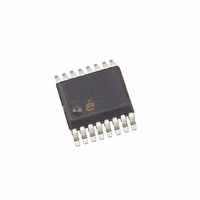ISL6549CAZA-T Intersil, ISL6549CAZA-T Datasheet - Page 10

ISL6549CAZA-T
Manufacturer Part Number
ISL6549CAZA-T
Description
IC CTRLR PWM SYNC BUCK 16-QSOP
Manufacturer
Intersil
Datasheet
1.ISL6549CAZR5213.pdf
(18 pages)
Specifications of ISL6549CAZA-T
Pwm Type
Voltage Mode
Number Of Outputs
2
Frequency - Max
1MHz
Duty Cycle
100%
Voltage - Supply
4.75 V ~ 13.2 V
Buck
Yes
Boost
No
Flyback
No
Inverting
No
Doubler
No
Divider
No
Cuk
No
Isolated
No
Operating Temperature
0°C ~ 70°C
Package / Case
16-QSOP
Frequency-max
1MHz
Lead Free Status / RoHS Status
Lead free / RoHS Compliant
Other names
ISL6549CAZA-TTR
Available stocks
Company
Part Number
Manufacturer
Quantity
Price
Part Number:
ISL6549CAZA-T
Manufacturer:
INTERSIL
Quantity:
20 000
For most situations, no external compensation is required for
the linear output. See “Linear Controller Feedback
Compensation” on page 12.
For both outputs, the selection of 1% resistors may not be
able to get the exact ratio desired for any given output voltage.
If the output must be defined better, then one option is to
place a much bigger resistor in parallel with R4 or R6, to lower
its value. For example, a 100kΩ in parallel with a 1.00kΩ
yields 990Ω, 1% below 1.00kΩ, which gives finer resolution
than the next lower size (976Ω 1%). The big resistor may not
have to be 1% tolerance either.
If the linear output is not required, connect the LDO_DR pin
directly to LDO_FB pin with no other components. This will
terminate the signals and keep the linear from tripping its
undervoltage, which would force both outputs into retry.
Converter Shutdown
Pulling and holding the FS_DIS pin near GND will shut down
both regulators; almost any NFET or other pull-down device
(<1kΩ impedance) should work. Upon release of the FS_DIS
pin, the regulators enter into a soft-start cycle which brings
both outputs back into regulation. The FS_DIS pin requires a
quiet GND to minimize jitter. To accomplish this, the FS
resistor and any pull-down device should be placed as close
as possible to the pin, and the GND should be kept away from
the noisy FET GND.
Boot Capacitor, Boot Refresh
A capacitor from the PHASE pin to the BOOT pin is required
for the bootstrap circuit for the Upper Gate. The V
(and thus the PHASE node) is allowed to go as high as a
nominal 12V (±10%) supply. A diode is included on the IC
(anode to PVCC5 pin, cathode to BOOT pin), such that the
PVCC5 (nominally around 5.25V) will be the bootstrap supply.
In the event that the UGATE is on for an extended period of
time, the charge on the boot capacitor can start to sag, raising
the R
detects a long UGATE on-time (32 oscillator clock periods),
V
C
FIGURE 8. OUTPUT VOLTAGE SELECTION OF THE LINEAR
OUT2
OUT2
V
IN2
DS(ON)
+
C
IN2
of the upper FET. The ISL6549 has a circuit that
V
(V
OUT2
+
OUT2
Q3
)
=
0.8
×
R5
⎛
⎝
1
10
+
R5
------- -
R6
⎞
⎠
R6
LDO_DR
LDO_FB
ISL6549
IN1
voltage
ISL6549
and forces the LGATE to go high for one oscillator cycle,
which allows the bootstrap capacitor time to recharge.
PWM Controller Feedback Compensation
This section highlights the design consideration for a
voltage-mode controller requiring external compensation. To
address a broad range of applications, a type-3 feedback
network is recommended (see Figure 9).
Figure 10 highlights the voltage-mode control loop for a
synchronous-rectified buck converter, applicable to the
ISL6549 circuit. The output voltage (V
reference voltage, VREF. The error amplifier output (COMP pin
voltage) is compared with the oscillator (OSC) modified
saw-tooth wave to provide a pulse-width modulated wave with
an amplitude of V
smoothed by the output filter (L and C). The output filter
capacitor bank’s equivalent series resistance is represented by
the series resistor E.
The modulator transfer function is the small-signal transfer
function of V
gain, given by d
filter, with a double pole break frequency at F
F
channel inductance and its DCR, while C and E represents
the total output capacitance and its equivalent series
resistance.
The compensation network consists of the error amplifier
(internal to the ISL6549) and the external R1-R3, C1-C3
components. The goal of the compensation network is to
provide a closed loop transfer function with high 0dB crossing
frequency (F
margin (better than 45 degrees). Phase margin is the difference
between the closed loop phase at F
equations that follow relate the compensation network’s poles,
zeros and gain to the components (R1, R2, R3, C1, C2, and
C3) in Figure 10.
F
CE
LC
FIGURE 9. COMPENSATION CONFIGURATION FOR ISL6549
. For the purpose of this analysis, L and D represent the
=
---------------------------
2π
⋅
R1
1
L C
OUT
0
; typically 0.1 to 0.3 of F
⋅
CIRCUIT
MAX
R2
/V
IN
COMP
at the PHASE node. The PWM wave is
V
C2
IN
R3
C3
C1
/V
. This function is dominated by a DC
OSC
F
CE
COMP
, and shaped by the output
=
----------------------- -
2π C E
FB
0dB
⋅
SW
OUT
1
V
and 180°. The
⋅
DIFF
) and adequate phase
) is regulated to the
ISL6549
(V
LC
OUT
September 22, 2006
and a zero at
)
FN9168.2
(EQ. 3)














